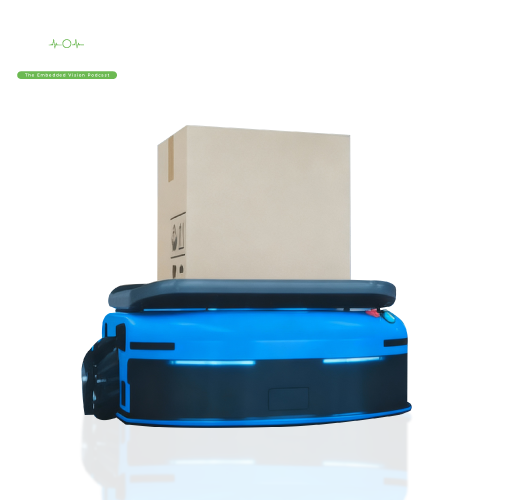Welcome to the 8th episode of Vision Vitals – e-con Systems' podcast on embedded vision technologies.
Today, we're turning our attention to Autonomous Mobile Robots, popularly known as AMRs, which have been gaining serious momentum,
These incredible robots, fuelled by embedded vision, are transforming factories, warehouses, and logistics centers across the world. But for them to move, react, and make decisions safely, one component matters above all: the camera system.
As always, helping us understand why camera selection is so crucial for AMR navigation and safety, we have an expert who knows this world inside out.
Hey, glad to be here. AMRs are one of the most exciting frontiers right now, and vision plays a massive role in their evolution.
So, let's start from the beginning. Why is camera selection such a critical part of AMR design?
Speaker:
To put things in a nutshell, cameras are the proverbial eyes of AMRs. They capture the visual information that drives everything, from localization and mapping to obstacle detection and motion planning.
A poorly chosen camera can break that chain. Incorrect exposure, limited dynamic range, or latency can cause drift or even unsafe movement.
That's why it's important for the cameras to enable consistent, low-latency, high-quality feeds, which are crucial for real-time navigation and safety.
Host:
That makes sense. Let's talk about navigation. How do cameras support AMRs in locating themselves and planning paths?
Speaker:
Navigation depends on Simultaneous Localization and Mapping. Cameras feed high-resolution image streams to the SLAM algorithm, helping it recognize landmarks, measure depth, and maintain positional accuracy.
Global shutter sensors prevent motion blur, so the AMR's perception remains sharp even when it's moving fast. HDR support ensures visibility across bright and dark zones in the same frame. It's something warehouses constantly struggle with.
So, this combination keeps mapping accurate and movement steady.
Host:
What about obstacle detection and collision avoidance?
Speaker:
That's where depth cameras and RGB-IR sensors step in. Depth cameras leverage Time-of-Flight (ToF) or stereo vision technology to provide accurate distance data in real time.
For example, e-con Systems' DepthVista series delivers high depth accuracy and low latency. It's especially useful when AMRs operate near humans or in dynamic environments.
Meanwhile, RGB-IR sensors combine visible and infrared imaging. This hybrid approach helps the robot see even in poor or mixed lighting conditions, like moving between indoor and outdoor zones.
Together, they give AMRs a full picture of their surroundings, whether near or far, bright or dim.
Host:
p class="text-justify">That's impressive. But AMRs also need to react fast, right? How does camera choice affect their response time?
Speaker:
Frame rate, bandwidth, and interface design all matter. A high-frame-rate global shutter camera ensures fast updates, so navigation decisions keep pace with motion.
Interfaces like GMSL2 deliver high-speed data transmission over long distances with minimal interference. This is critical for multi-camera setups, be it front, rear, or side, where synchronization is vital for safe maneuvering.
Basically, faster image delivery means quicker reaction time, which directly translates into operational safety.
Host:
Lighting conditions are rarely ideal inside warehouses or factories. How do AMR cameras handle that challenge?
Speaker:
Through advanced imaging features and smart hardware design. Cameras like e-con Systems' STURDeCAM31 or STURDeCAM88 use HDR sensors and NIR support to adapt to low-light and high-contrast conditions.
That means an AMR can move from a bright loading bay to a dark aisle without losing clarity or depth accuracy.
Mechanical reliability also matters. e-con Systems cameras come with rugged, IP-rated enclosures and thermal stability for 24/7 operation. So even when the environment shifts, performance stays stable.
Host:
Interesting. What factors should engineers consider when choosing the right camera for their AMR?
Speaker:
Start with the application itself.
If it's for navigation, choose high-frame-rate global shutter cameras. If it involves object or pallet detection, go for high-resolution RGB sensors. If safety monitoring is key, use depth or RGB-IR cameras.
For dynamic lighting, HDR-enabled sensors are the right pick.
The interface also makes a difference. MIPI suits compact SoC-based boards. USB helps in testing and prototyping. GMSL2 works best for long-distance, high-bandwidth designs.
At the end of the day, matching the camera, ISP, and compute platform ensures smooth integration.
Host:
Speaking of integration, how does e-con Systems simplify that process?
Speaker:
Through ready-to-use imaging pipelines. e-con Systems' AMR cameras are tuned using the TintE ISP, which optimizes color accuracy, exposure, and noise reduction.
It means developers don't waste time adjusting parameters. The camera feed is already optimized for AI models running on NVIDIA Jetson AGX Orin or Orin NX.
It also shortens the path from prototype to production and guarantees consistent image quality in every deployment.
Host:
Let's talk about real-world use cases. Where are these cameras already making an impact?
Speaker:
Plenty of places.
For instance, in warehouse automation, AMRs use stereo and depth cameras to navigate tight aisles and avoid human workers. Or in factory logistics, RGB cameras read barcodes and QR codes for docking accuracy.
Then, in outdoor setups, HDR and NIR sensors ensure reliable perception in sunlight or dim light.
These examples highlight how the right imaging system directly influences safety, uptime, and throughput.
Host:
It sounds like choosing the right camera can define how intelligent an AMR really is.
Speaker:
Exactly. The wrong camera can limit perception, delay reaction, or compromise safety. The right one unlocks full autonomy and faster decision-making.
That's why e-con Systems offers a complete AMR camera portfolio. We bring together rugged design, tuned ISPs, and validated support for NVIDIA and other leading embedded vision platforms to help developers achieve robust, scalable performance.
Host:
Perfectly summed up.
That brings us to the end of today's Vision Vitals.
We've seen how camera selection directly impacts AMR navigation, safety, and operational intelligence.
To explore e-con Systems' full range of AMR vision solutions, visit www.e-consystems.com.
Stay tuned for the next episode as we continue exploring the wonderful world of embedded vision.
As always, stay future-ready for all things vision-related!
Close Full Transcript



 Mr. Thomas Yoon
Mr. Thomas Yoon +82-10-5380-0313
+82-10-5380-0313










